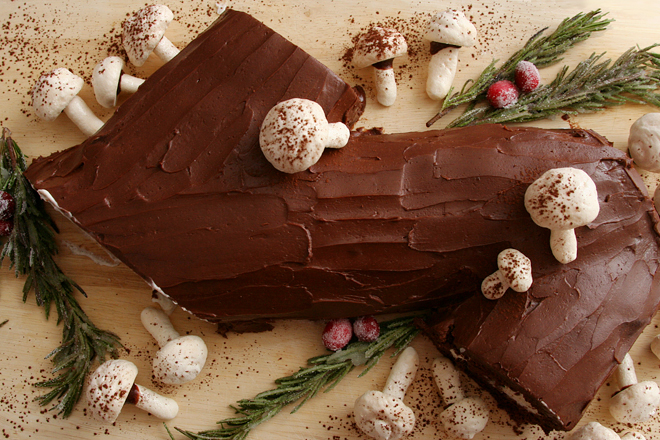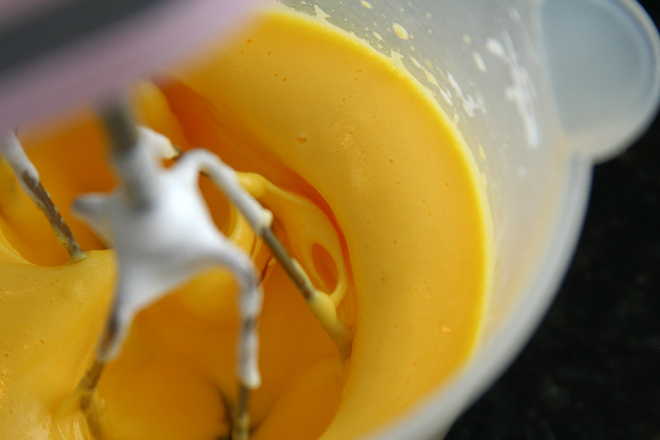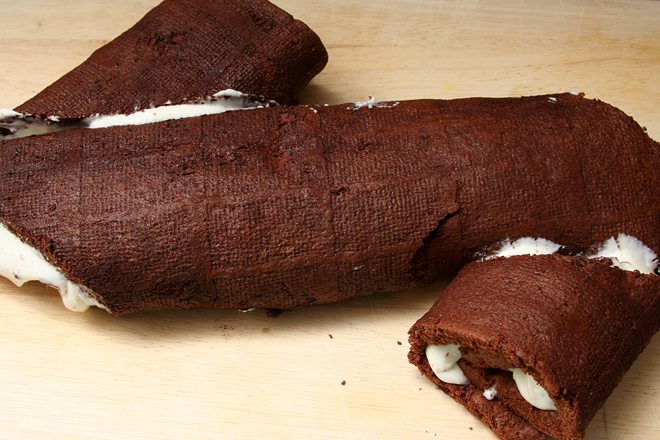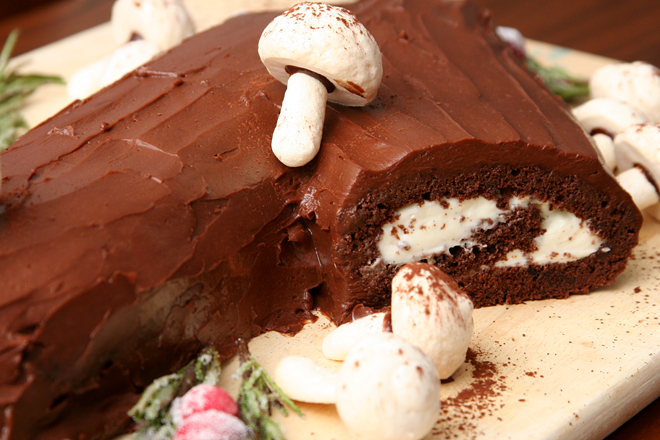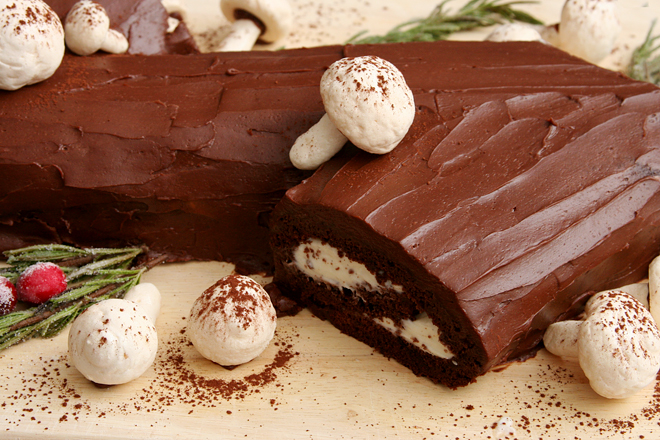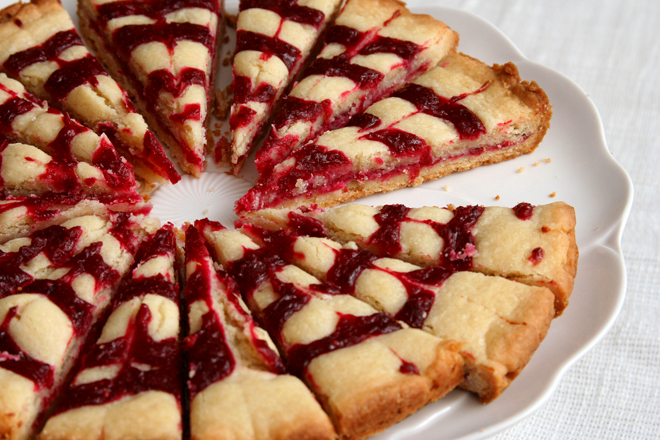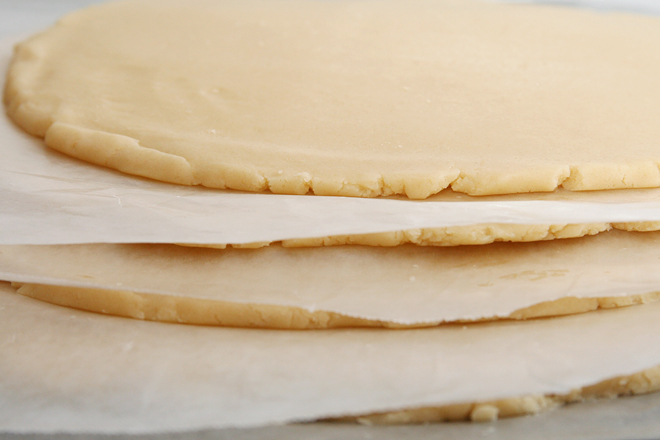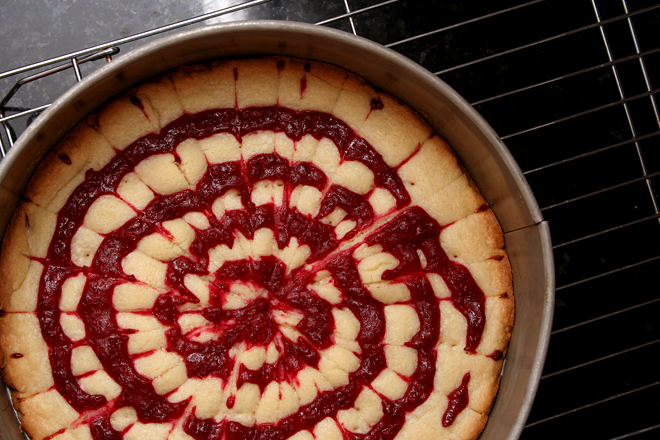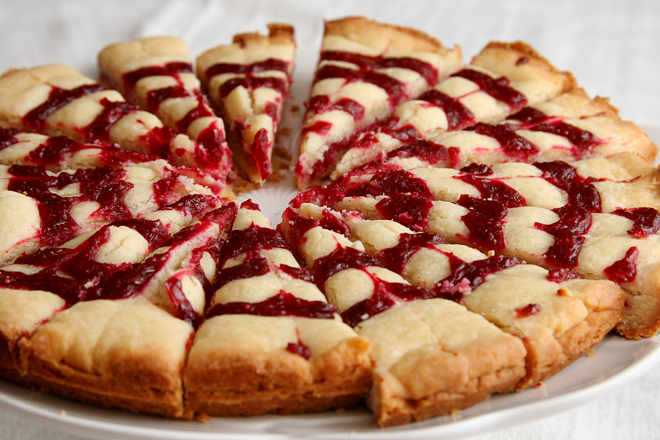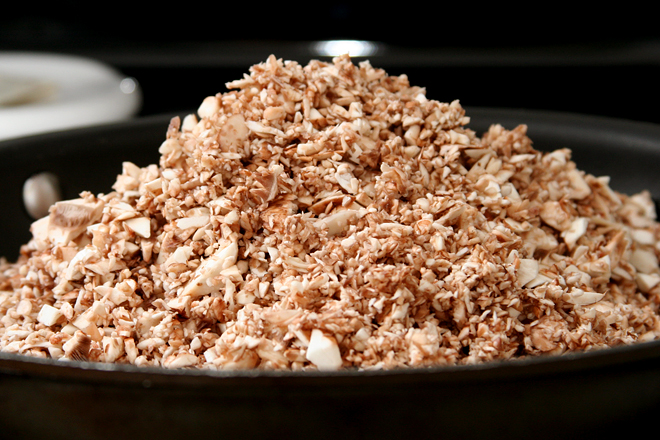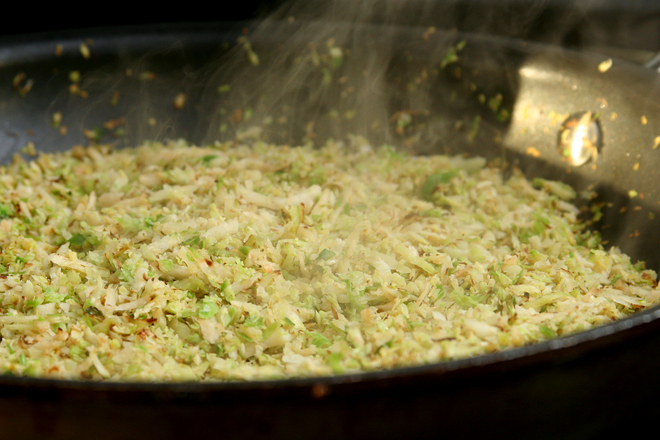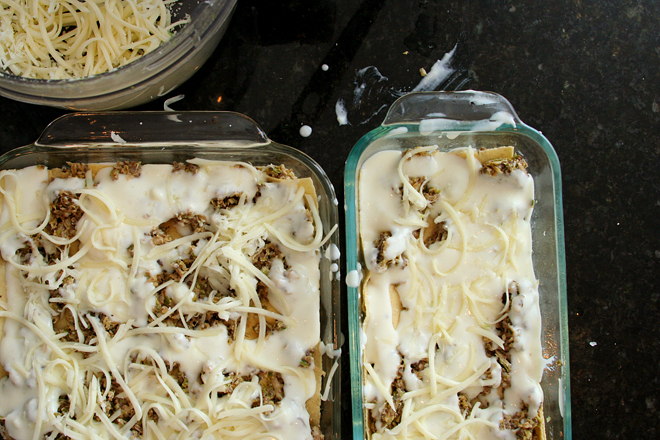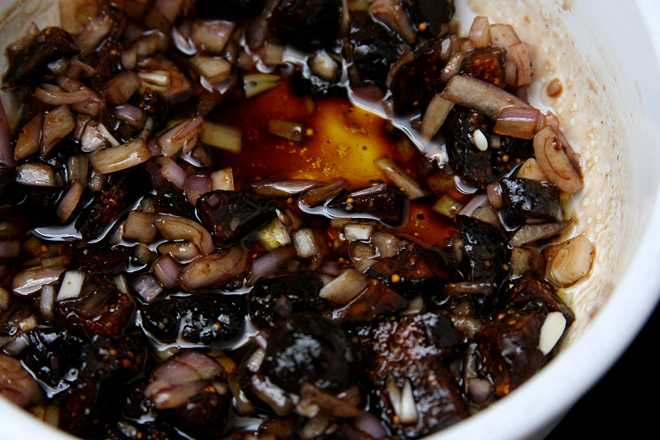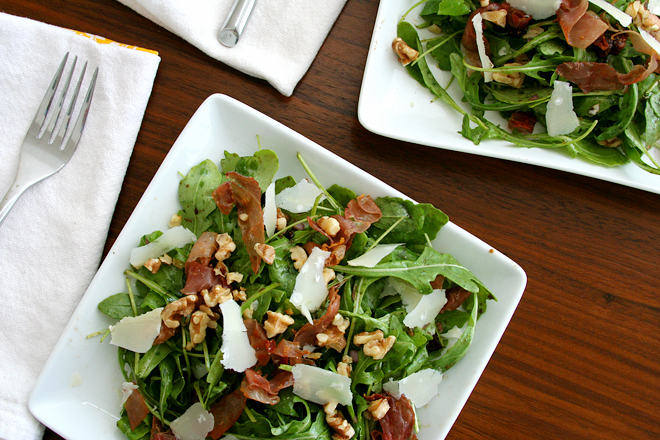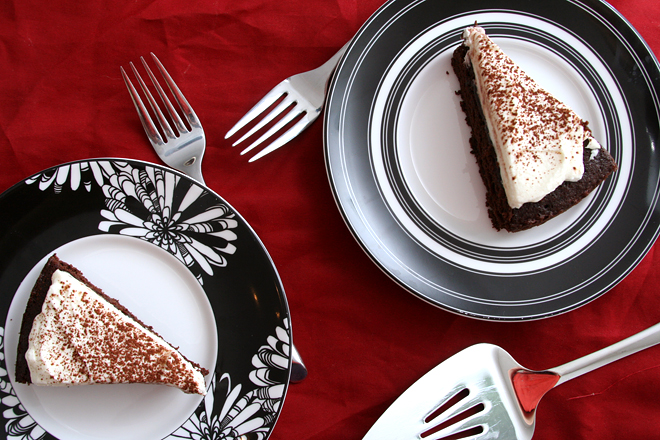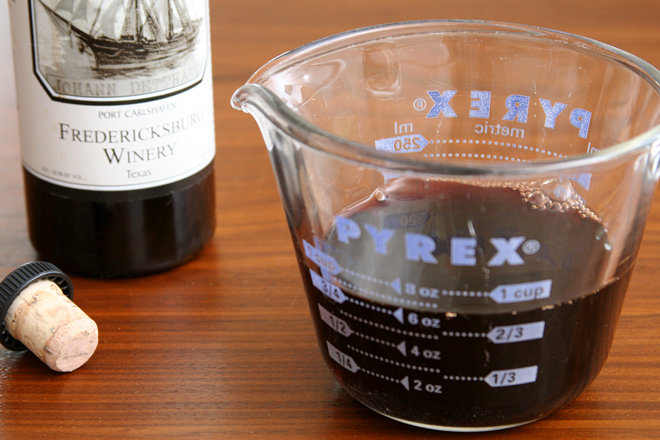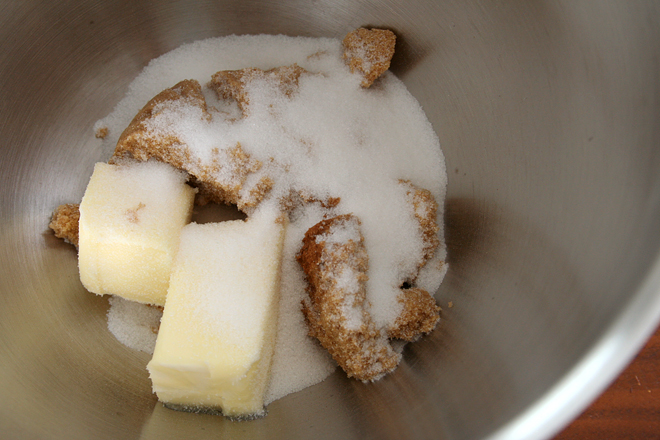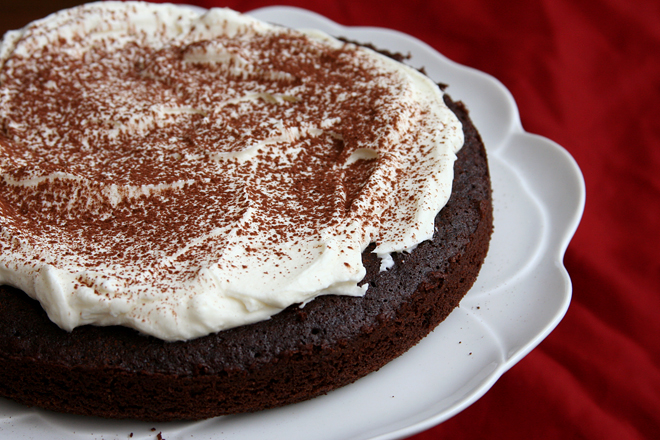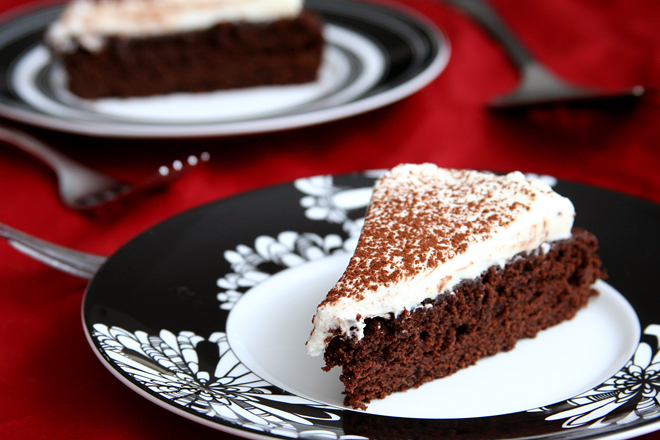I was tense for the entire 2½ hours I spent making this cake. I’d signed up to bring it to the office holiday party potluck, and I wasn’t sure which title was more commonly known, yule log or buche de noel, so I wrote down both. This was a mistake; several hours later, Big Boss came barreling down the hall blustering about using fancy French words and/or bringing a piece of wood to the party.
He was mollified when I told him it was a cake. “Chocolate”, he asked? “Um, yes, chocolate”, even though I hadn’t really planned on chocolate.
So I felt like the stakes were high. And considering that I hadn’t made a rolled cake in seven years, the risk was high as well. This is why I spent all afternoon nervous, waiting to make a mistake that would result in a cake disaster.
There were no cake disasters. It wasn’t a perfectly smooth process – the grocery store ran out of mascarpone, the cake cracked when I rolled it, my baking pan is too small so the spiral was loose, the ganache didn’t set up, the cake cracked again when I tried to move it, and the last minute sugared rosemary and cranberries I made for decorations weren’t dry so the sugar dissolved instead of sparkled – but there was nothing that a little ganache couldn’t cover up. Once the ganache was frantically put in the freezer so it would set, that is.
Substituting cream cheese for mascarpone worked in my favor in the end, because when Big Boss asked me what the filling was made of, I told him cream cheese and didn’t mention the mascarpone. I’ve learned my lesson about fancy European words. Fortunately, the cream cheese/mascarpone filling really was delicious, just like the chocolate cake, and the ganache. Even the mushrooms were all gone by the time we left the party. It was an unqualified success; still, next year I’m bringing all-American cheesecake.
Printer Friendly Recipe
Bittersweet Chocolate Yule Log (slightly adapted from Cook’s Illustrated)
Serves 8 to 10
The ganache didn’t firm up for me in an hour at room temperature, so I put it in the refrigerator for a 10 minutes or so before icing the cake.
I was afraid to move the cake after it was formed and frosted, so I put it together directly on the serving plate. I slipped thin strips of wax paper under the edges of the cake to catch extra ganache, then discarded the strips before serving.
My grocery store ran out of mascarpone, so I used half mascarpone and half cream cheese in the filling, which worked very well.
The original recipe calls for an espresso-flavored filling instead of vanilla, but I didn’t think espresso would be as popular with the crowd I served this to. If you’d rather have the espresso, replace the vanilla flavorings in the mascarpone cream with 2 teaspoons espresso powder.
Dark Chocolate Ganache:
¾ cup heavy cream
2 tablespoons unsalted butter
6 ounces semisweet chocolate (high-quality), chopped
1 tablespoon Cognac or brandy
Vanilla Bean-Mascarpone Cream:
½ cup heavy cream
seeds from 1 vanilla bean
1 teaspoon vanilla extract
6 tablespoons confectioners’ sugar (1½ ounces)
16 ounces mascarpone cheese (about 2 cups)
Roulade:
¼ cup unbleached all-purpose flour (about 1¼ ounces), plus more for dusting baking sheet
6 ounces bittersweet chocolate or semisweet chocolate, chopped fine
2 tablespoons cold unsalted butter, cut into two pieces
2 tablespoons cold water
¼ cup cocoa (¾ ounce), Dutch-processed, sifted, plus more for unmolding and garnish
⅛ teaspoon table salt
6 large eggs, separated, room temperature
⅓ cup granulated sugar (2⅓ ounces)
1 teaspoon vanilla extract
⅛ teaspoon cream of tartar
1. For the Dark Chocolate Ganache: Bring the cream and butter to a simmer in a small saucepan over medium-high heat. Place the chocolate in the bowl of a food processor fitted with the steel blade. With the machine running, gradually add the hot cream and brandy through the feed tube and process until smooth and thickened, about 3 minutes. Transfer the ganache to a medium bowl and let stand at room temperature 1 hour, until spreadable (ganache should have consistency of soft icing).
2. For the Vanilla Bean-Mascarpone Cream: Bring the cream to a simmer in a small saucepan over high heat. Remove from the heat and stir in the vanilla seeds, extract, and confectioners’ sugar; cool slightly. With a rubber spatula, beat the mascarpone in a medium bowl until softened. Gently whisk in the cooled cream mixture until combined. Cover with plastic wrap and refrigerate until ready to use.
3. For the Roulade: Adjust an oven rack to the upper-middle position and heat the oven to 400 degrees. Spray an 18 by 12-inch rimmed baking sheet with nonstick cooking spray, cover the pan bottom with parchment paper, and spray the parchment with nonstick cooking spray; dust baking sheet with flour, tapping out excess.
4. Bring 2 inches of water to a simmer in a small saucepan over medium heat. Combine the chocolate, butter, and water in a small heatproof bowl and cover tightly with plastic wrap. Set the bowl over the saucepan, reduce the heat to medium-low, and heat until the butter is almost completely melted and the chocolate pieces are glossy, have lost definition, and are fully melted around edges, about 15 minutes. (Do not stir or let water in saucepan come to boil.) Remove the bowl from heat, unwrap, and stir until smooth and glossy. While the chocolate is melting, sift the cocoa, flour, and salt together into a small bowl and set aside.
5. In the bowl of a standing mixer, beat the egg yolks at medium-high speed until just combined, about 15 seconds. With the mixer running, add half of the sugar. Continue to beat, scraping down the sides of the bowl as necessary until the yolks are pale yellow and the mixture falls in a thick ribbon when the beaters are lifted, about 8 minutes. Add the vanilla and beat to combine, scraping down the bowl once, about 30 seconds. Turn the mixture into a medium bowl; wash the mixer bowl and beaters and dry with a kitchen towel. (If you have 2 mixer bowls, leave the yolk mixture in the mixer bowl; wash and dry the beaters and use second bowl in step 6.)
6. In a clean bowl with clean beaters, beat the egg whites and cream of tartar at medium speed until foamy, about 30 seconds. With the mixer running, add about 1 teaspoon of the remaining sugar; continue beating until soft peaks form, about 40 seconds. Gradually add the remaining sugar and beat until the egg whites are glossy and supple and hold stiff peaks when the whisk is lifted, about 1 minute longer. Do not overbeat (if the whites look dry and granular, they are overbeaten). While the whites are beating, stir the chocolate mixture into the yolks. With a rubber spatula, stir a quarter of the whites into the chocolate mixture to lighten it. Fold in the remaining whites until almost no streaks remain. Sprinkle the dry ingredients over the egg and chocolate mixture and fold in quickly but gently.
7. Pour the batter into the prepared pan; using an offset icing spatula and working quickly, smooth the surface and spread the batter into the pan corners. Bake until the center of the cake springs back when touched with a finger, 8 to 10 minutes, rotating the pan halfway through the baking time. Cool the cake in the pan on a wire rack for 5 minutes.
8. While the cake is cooling, lay a clean kitchen towel over a work surface and sift 1 tablespoon cocoa over the towel; with your hands, rub the cocoa into the towel. Run a paring knife around the perimeter of the baking sheet to loosen the cake. Invert the cake onto the towel and peel off the parchment.
9. For the finished cake: Starting at a long side, roll the cake and towel together into a jelly roll shape. Cool for 15 minutes, then unroll the cake and towel. Using an offset spatula, immediately spread the mascarpone cream filling evenly over the surface of the cake, almost to the edges. Reroll the cake gently but snugly around the filling. Set a large sheet of parchment paper on an overturned rimmed baking sheet and set the cake seam-side down on top. Trim both ends of the cake on a diagonal. Reserve ¼ cup of ganache for attaching meringue mushrooms. Spread the remaining ganache over the roulade with a small icing spatula. Use a fork to make wood-grain striations on the surface of the ganache before it has set. Refrigerate the cake, uncovered, on a baking sheet to slightly set the icing, about 20 minutes.
10. When ready to serve, carefully slide two wide metal spatulas under the cake and transfer the cake to a serving platter. Arrange the meringue mushrooms around the cake, attaching them with dabs of reserved ganache. Sift a light dusting of cocoa over the mushrooms. Sift the yule log with confectioners’ sugar. Serve within 2 hours.
Meringue Mushrooms (from Cook’s Illustrated)
Makes about 30
I didn’t need 30 mushrooms, so I cut the recipe in half, using a hand mixer and a small mixing bowl. Although maybe 30 mushrooms wouldn’t have been so bad, considering how smooth and airy and delicious these were.
CI note: If the caps and stems become soggy during storage, crisp them in a 200-degree oven for 30 minutes before assembling the mushrooms.
¼ cup water
½ cup (3.5 ounces) granulated sugar
2 large egg whites, room temperature
Pinch table salt
⅛ teaspoon cream of tartar
½ teaspoon vanilla extract
1. Adjust oven racks to the middle and lowest positions and heat the oven to 200 degrees. Line 2 rimmed baking sheets with parchment paper.
2. Combine the water and sugar in heavy saucepan. Cover and bring to a boil over medium-high heat. Boil, swirling the pan once or twice, until the sugar has dissolved, 1 to 2 minutes. If necessary, wipe down any sugar crystals on the side of the pan with a damp pastry brush. Cook, uncovered, until the temperature registers 238 degrees on a candy thermometer, about 10 minutes.
3. While the sugar is cooking, place the egg white in the bowl of a standing mixer fitted with the whisk. Beat at medium-low speed until frothy, about 1 minute. Add the salt and cream of tartar and beat, gradually increasing speed to high, until the whites hold soft peaks, about 1 minute.
4. With the mixer at medium speed, slowly pour the hot syrup into the egg whites, avoiding the whisk. Increase the speed to medium-high and continue to beat until the meringue cooks to room temperature and becomes very thick and shiny, 5 to 10 minutes. Using a rubber spatula, fold in the vanilla.
5. Fit a pastry bag with a ¼-inch pastry tip and fill with the meringue. Pipe about 30 caps and an equal number of stems onto the prepared pans.
6. Bake the meringues for 2 hours, then turn off the oven, leaving the meringues in the oven until very dry and crisp, about 30 minutes longer. Cool the mushroom caps and stems on the baking sheets. (Caps and stems may be stored in an airtight container for up to 1 week.) To assemble the mushrooms, use ganache to glue the caps and stems together.
